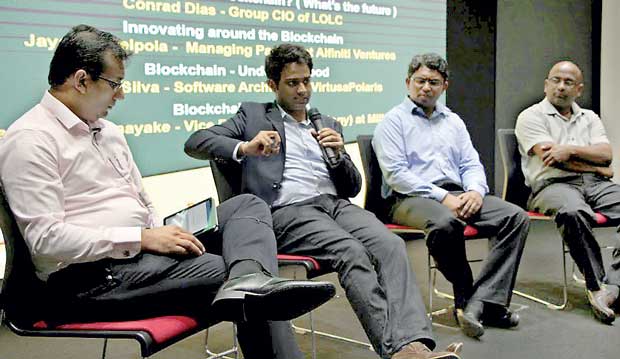Reply To:
Name - Reply Comment

At the heart of digital currency is a powerful, decentralized technology that is now revolutionizing the way people around the world exchange value.
Called the ‘Blockchain’, this innovative solution is an incorruptible digital ledger of economic transactions that can be programmed to record not just financial transactions but virtually everything of value.
This topic was the key focus of an interesting Tech Talk recently held by SLASSCOM, at the Dialog Auditorium in Colombo 02.
The eminent panel of experts that addressed a gathering of CIO’s of many blue chip and technology companies , comprised of LOLC Group CIO Conrad Dias, Alfiniti Ventures Managing Partner Jayamin Pelpola, Millennium IT-Vice President Tharundu Dissanayake and VirtusaPolaris Software Architect Omega Silva.
Commencing the discussion, Conrad Dias gave an in depth explanation on “Breaking down the Blockchain” and said “The Blockchain is a block which records some or all transactions, and once completed goes into the Blockchain as a permanent database. Each time a block gets completed, a new block is generated. There is a countless number of such blocks in the blockchain which are linked to each other like a chain in a proper linear and in chronological order, with every block containing a hash of the
previous block.”
Information held on a Blockchain exists as a shared and continually reconciled database that isn’t stored in any single location. The records are easily verifiable and are hosted by millions of computers simultaneously, with the data being accessible to anyone on the internet.
There also exists certain private Blockchains, where access permissions are more tightly controlled, with rights to modify or read the Blockchain state restricted to a few users, while still maintaining partial guarantees of authenticity and decentralization .However there is no centralized version of information, making it almost impossible for a hacker to corrupt..
Being a mechanism that calls for everyone using it to be accountable to the highest degree, it guarantees in not having any missed transactions, human or machine errors, and ensures the validity of a transaction and it’s immutability by recording all transactions not only on a main register but a connected distributed system of registers, all of which are connected through a secure validation mechanism. The Blockchain also automatically reconciles every transaction that happens in ten-minute intervals, giving it transparency and being uncorrupt able. It also allows for asset transferability, transaction traceability and faster settlement.
Conrad also cited examples of Blockchain platforms such as Bitcoin, Ethereum, Hyperledger and Ripple.
JayaminPelpola next addressed the audience on “Innovating around the distributed Blockchain.”.He said that the Blockchainprotocols allows payments to occur in near-real time without the need to route payments through a complicated trail of banks. It has no concept of a domestic or foreign payment, which gives the system the potential to cut through a swathe of complications which affect innumerable cross-border payments every single day .The Blockchain therefore improves the speed and security of cross-border payments and leads to a remarkable increase in the speed and surety of business transactions being performed worldwide. He affirmed that companies such as VISA are already adopting the Blockchain.
Adding to these comments Mr. Omega Silva explained to the crowd the underlying concepts of BlockChain,focusing on how double spending problems are prevented and how the participants in the BlockChain network collaboratively to decide the next block in the chain. He also explained why it’s difficult for a malicious user alter the contents of the BlockChain.
This was followed by a presentation made by Tharundu Dissanayake who outlined on building decentralized applications on the Blockchain’. He explained that decentralized applications are server-less applications that can be run jointly on the client side and within a blockchain based distributed network, such as Ethereum. The client device manages the front-end and user credentials, while the back-end runs within a distributed network of computers that provide for the processing and storage requirements. It has the benefit of providing stronger security, resilience, decentralized control, accountability and significant control to end-users on their credentials, data, and communications
The Tech Talk concluded with a panel discussion, participated by all the speakers who deliberated about the way forward in using the Blockchain.